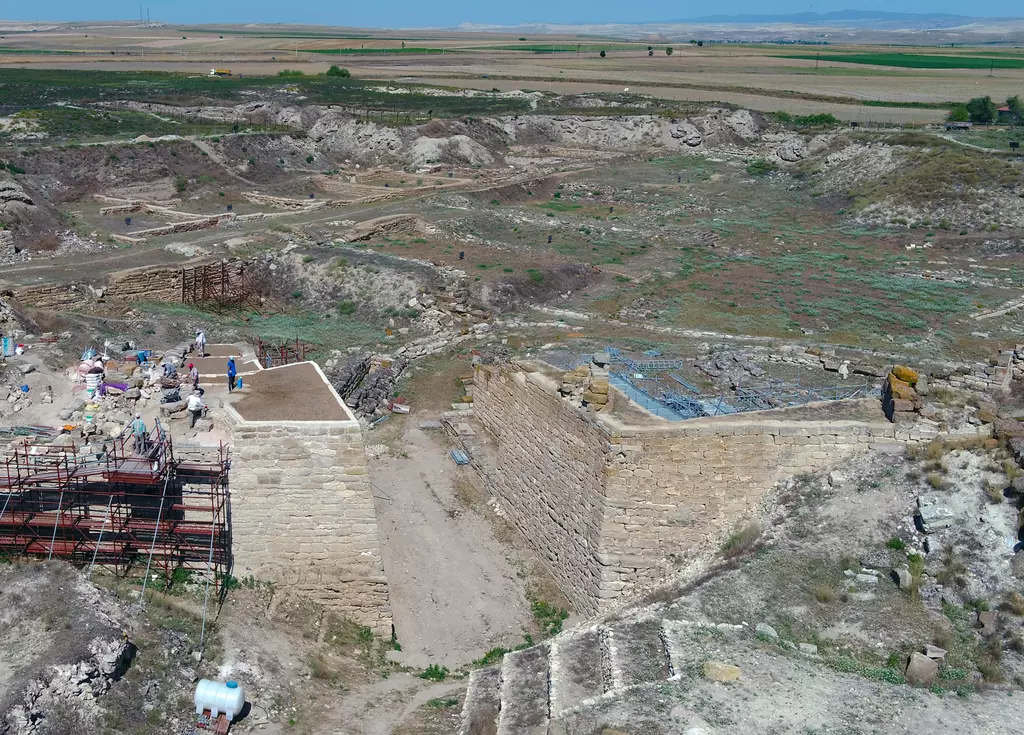
Why Visit Gordion?
- Step into the world of legends—walk the same ground as King Midas and Alexander the Great.
- See one of the oldest wooden structures in history, dating back over 2,700 years.
- Explore an ancient Phrygian city with remarkably well-preserved ruins.
- Enjoy a peaceful, off-the-beaten-path historical experience, away from crowded tourist sites.
👉 Pro Tip: The best time to visit is spring or autumn, when the weather is mild, and the surrounding Anatolian landscape is at its most picturesque. Make sure to wear comfortable shoes, as you’ll be exploring open fields and archaeological ruins.
Gordion: The Ancient Capital of the Legendary King Midas
- Hidden in the heart of Central Anatolia, just 80 km southwest of Ankara, lies Gordion, an ancient city that once served as the capital of the Phrygian Kingdom. This UNESCO World Heritage site is most famously associated with King Midas, the legendary ruler said to have turned everything he touched into gold. Today, Gordion offers an extraordinary journey into 3,000 years of history, showcasing massive burial mounds, ruins of ancient settlements, and the legendary Gordian Knot, a riddle that only Alexander the Great could solve.
Historical Significance
- Gordion's history dates back to at least 1200 BCE, but it flourished during the 9th–8th centuries BCE as the Phrygian capital. The city became a major political and cultural center, famous for its advanced craftsmanship, defensive structures, and royal burials.
- One of its most famous legends is the Gordian Knot, a complex knot tied to the city’s temple. According to prophecy, whoever untied the knot would become the ruler of Asia. When Alexander the Great arrived in 333 BCE, he famously cut through it with his sword, claiming his destiny to conquer the Persian Empire.
- Over the centuries, Gordion fell under Lydian, Persian, Greek, Roman, and Byzantine rule, each civilization leaving behind its mark in the ruins we see today.
Must-See Attractions in Gordion
1. King Midas’ Tumulus (The Great Mound)
- The largest burial mound in Gordion, standing 53 meters high and 300 meters in diameter, is believed to be the tomb of King Midas’ father, Gordios.
- Visitors can enter the ancient wooden burial chamber, one of the oldest surviving wooden structures in the world, dating back to 740 BCE.
- Inside, archaeologists found stunning Phrygian artifacts, including beautifully crafted furniture and bronze vessels, many of which are now displayed in the Museum of Anatolian Civilizations in Ankara.
2. Gordion Archaeological Site (Ancient City Ruins)
- Walk through the remains of Phrygian-era fortifications, city walls, and palaces, giving insight into ancient urban life.
- Explore the Megaron buildings, which were used for royal ceremonies, feasts, and governance.
- Discover evidence of Alexander the Great’s conquest, including signs of destruction and rebuilding from the Hellenistic period.
3. The Gordian Knot Legend Site
- Though the original Gordian Knot is lost to history, the spot where Alexander the Great allegedly cut it is marked, making it a must-visit for history buffs and mythology enthusiasts.
4. Gordion Museum
- Located near the excavation site, the museum houses incredible Phrygian artifacts, including pottery, weapons, jewelry, and remnants of the legendary Midas’ golden touch myth.
- Detailed reconstructions of how the city once looked help visitors imagine life in ancient times.